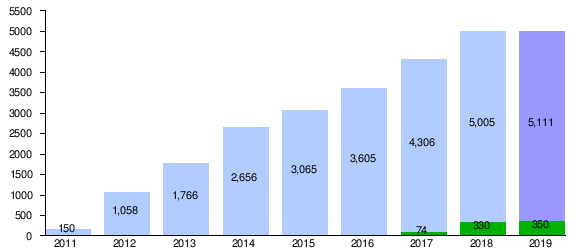When e-commerce breaks the limits of physical location and moves everything online, some will say restaurant businesses are safe, since people need to dine locally.
But that’s not entirely true. If there are companies eager to learn consumers’ purchasing behavior (via all the data generated from browsers), they won’t let go the valuable data on people’s dining behavior. And of course, wherever there is an opportunity for recommendations, there is an opportunity for ads.
So first step: collecting data.
There are several formats.
- Purchasing through brands’ apps. That’s what we have seen in the past few years: nearly all major restaurant/coffee groups built their own system that at least integrate customer management, online order and promotion. Starbucks, McDonald’s, Subway, Shake Shack, etc.
- Ordering on iPad when dining-in. That makes taking orders less labor-intensive. It can also let diners order ahead and improve the overall efficiency/utilization including kitchen process optimization.
- Take-out & food delivery. This is where most money is in right now. DoorDash, Postmates, UberEats… [See more in a previous post (Chinese)] It is a more comprehensive study at user’s preferences, integrating most dining choices.
- Booking tables. This is a cheaper/lighter operating model than format 3 while also getting a big picture of users’ preferences. Sometimes it is combined with format 3 like Yelp’s offering.
- Restaurant table management. This is usually a back-end system for employees to use, but could be combined with format 2/4 to create a streamline management experience.
Just a few days ago, the dining data issue escalated as companies are fighting for its “ownership” or “commercial/economic potentials”.
At the spotlight: OpenTable (format 4) and SevenRooms (format 5), reported in WSJ: Who Controls Diners’ Data? OpenTable Moves to Assert Control.
Background:
OpenTable is a restaurant reservation service that allows patrons to book tables from the Web. Restaurants pay OpenTable $1.50 for every seated diner who reserves a table through its service. OpenTable also operates a guest-services platform to help restaurants run more smoothly.
SevenRooms charges restaurants $500 per month for its offering, takes the guest information from OpenTable and assists restaurants with table management. Under the new policy, some restaurateurs had featured, that practice would be banned.
Source: http://fortune.com/2019/03/15/opentable-data/
Essentially, OpenTable will now require a fee if the restaurants are giving other companies access to diners’ data. OpenTable will now charge restaurant operators $250 if they use both systems.
Both companies are resourceful; OpenTable is more established and mature. OpenTable is acquired by Priceline (Booking Holdings) in 2014 for $2.6 billion and behind SevenRooms is Amazon (Alexa Fund invested in October 2018).
While I believe in the improved management efficiency and dining experiences, I am also concerned with personalization. It is possible that personalized menu will include personalized bundle of foods and different mark-ups. And dining information could be more personal than most people understand. It includes timing, location, frequency, spending… Think about a database of how much drinks you ordered with different group of friends.. When combined with other datasets, powerful predictions and precise understandings of the diners could be built. [A similar comment on this: users being programmed on social medias]
Again, the privacy issue and the access/user/process of data should be paid more attention to before bad things could happen…



